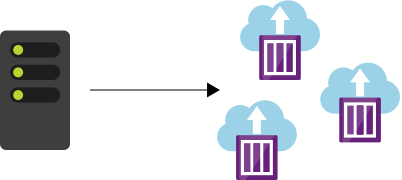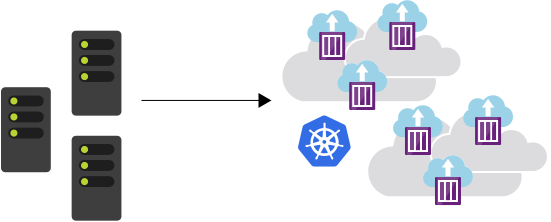What is Kubernetes?
The decoupled design of microservices combined with the atomicity of containers makes it possible to scale out apps that respond to demand. In complex solutions like the drone-tracking app, the process of deploying, updating, monitoring, and removing containers introduces challenges.
Before looking at what's in Kubernetes, there are two concepts that you should understand first: container management and orchestrators.
What is container management?
Container management is the process of organizing, adding, removing, or updating a significant number of containers.
The drone-tracking app consists of multiple microservices responsible for tasks like caching, queuing, or data processing. Each of these services is hosted in a container that's deployed, updated, and scaled independently from one another.

For example, with the drone-tracking app's website, you find that you need more instances of the site's caching service to maintain performance during specific times of the day, so you add more caching service container instances.
Next, assume that you've increased the number of caching instances and need to roll out a new version of the microservice. You need to update all the active containers to use the new version.
Container management helps you with these manual repetitive tasks.
What is a container orchestrator?
A container orchestrator is a system that automatically deploys and manages containerized apps. As part of management, the orchestrator handles scaling dynamic changes in the environment to increase or decrease the number of deployed instances of the app. It also ensures all deployed container instances are updated when a new version of a service is released.
Define Kubernetes
Kubernetes is a portable, extensible open-source platform for managing and orchestrating containerized workloads. Kubernetes simplifies complex container-management tasks and provides you with declarative configuration to orchestrate containers in different computing environments. This orchestration platform gives you the same ease of use and flexibility you might already know from platform as a service (PaaS) or infrastructure as a service (IaaS) offerings.

Kubernetes benefits
The benefits of using Kubernetes are based on the abstraction of tasks.
These tasks include:
Self-healing of containers; for example, restarting containers that fail or replacing containers
Scaling deployed container count up or down dynamically, based on demand
Automating rolling updates and rollbacks of containers
Managing storage
Managing network traffic
Storing and managing sensitive information such as usernames and passwords
Important
Keep in mind that all of the preceding aspects of Kubernetes require configuration and a good understanding of the underlying technologies. For example, you need to understand concepts such as virtual networks, load balancers, and reverse proxies to configure Kubernetes networking.
Kubernetes considerations
With Kubernetes, you can view your datacenter as one large compute resource. You don't need to worry about how and where you deploy your containers, only about deploying and scaling your apps as needed.
However, it's important to understand that Kubernetes isn't a single installed app that comes with all possible components needed to manage and orchestrate a containerized solution:
Aspects such as deployment, scaling, load balancing, logging, and monitoring are all optional. You're responsible for finding the best solution that fits your needs to address these aspects.
Kubernetes doesn't limit the types of apps that can run on the platform. If your app can run in a container, it can run on Kubernetes. To make optimal use of containerized solutions, your developers need to understand concepts such as microservices architecture.
Kubernetes doesn't provide middleware, data-processing frameworks, databases, caches, or cluster-storage systems. All these items are run as containers or as part of another service offering.
For Kubernetes to run containers, it needs a container runtime like Docker or containerd. The container runtime is the object that's responsible for managing containers. For example, the container runtime starts, stops, and reports on the container's status.
You're responsible for maintaining your Kubernetes environment. For example, you need to manage OS upgrades and the Kubernetes installation and upgrades. You also manage the hardware configuration of the host machines, such as networking, memory, and storage.
Cloud services such as Azure Kubernetes Service (AKS) reduce these challenges by providing a hosted Kubernetes environment. These services also simplify deploying and managing containerized apps in Azure. With AKS, you get the benefits of open-source Kubernetes without the complexity or operational overhead of running your own custom Kubernetes cluster.
Note
Kubernetes is sometimes abbreviated to K8s. The 8 represents the eight characters between the K and the s of the word K[ubernete]s.